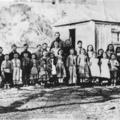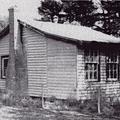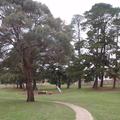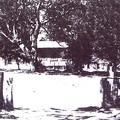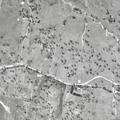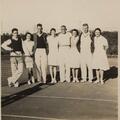< Early Canberra Government Schools
Weetangera School [1875 - 1937]
A Brief History of Weetangera School and its teachers [1875-1920]
By 1881 there were about twenty seven small farms in the Weetangera area, with 110 dwellings and a population of 554, approximately half the size of the town of Queanbeyan. These early settlers first approached the Council of Education in Sydney for a school in 1875. Inspector Manyard indicated that he would consider an application for a full time school at Weetangera. After permission was granted in 1875 a school building was constructed by the parents on the Weetangera road in the north west corner of Blundell's Portion 68. The schoolroom, measuring sixteen by twelve feet, was made of blue gum and box posts, slab walls, stringy bark flooring and a shingled roof. Parents also provided desks and benches, and were prepared to make a table and chair for the teacher. The school was located on land that is now a small park between Smith Street and Belconnen Way in Weetangera.
A potential teacher was found within the community itself. Mr Ewan Cameron, one of the parents, was seen as sufficiently educated to assume the role of teacher. Weetangera Provisional School opened on April 26 with an attendance of twenty seven children. Attendances over the next few decades fluctuated significantly, as parents often kept their children home to help with harvesting and other farm chores. Attendances at the school did however continue to increase and on 22 August 1877 the school council lodged a request with the Council of Education to have the school upgraded from its status as a Provisional School to a Public School. The application was approved and as the current teacher Ewan Cameron had continued with this studies he was now suitably qualified and duly appointed to the new Public School.
Enrolments at Weetangera did not improve over the next few years and in August 1881 Ewan Cameron left the school, transferring to a more secure position at Mugwill. A new teacher, Miss Bridget Roche was appointed to Weetangera on 11 August 1881. As a number of the families had left the district, Weetangera became a Provisional School once more, with less than twenty pupils enrolled. Enrolments dropped even further by the start of the 1882 school year and Miss Roche was clearly unhappy about that. On 28 March 1882 she wrote to the Department requesting a transfer to a larger school. On 2 June 1882 Miss Roche left the school for a new position at Barwang.
I was not until June 1883, twelve months later, that the families living in the Weetangera area approached the Department again. In the meantime the children would not have attended school at all. Although education was compulsory, children living more than two miles from the nearest school were granted exemptions, and the schools closest to Weetangera could not be reached by foot. Stone Hut School was six miles away and Ginninderra ten miles by the main road, according to parents' estimates.
The new application indicated some changes to the families resident in the district. Approval was granted for the school to be re-opened as a Provisional School and a suitable teacher sought. The new teacher was Miss Grace Jamieson, from Wantabadgery Provisional School. Not much is known about her time at Weetangera, but on 14 November 1884 she was transferred and a new teacher, Walter Scott, was appointed. Again there were no details, but Walter Scott resigned one month later in December 1884.
Miss Mary Nolan was the fifth teacher to be appointed to Weetangera, commencing on 21 February 1885. However the Inspector's Report on 12 August 1885 raised the question once again of the viability of the school as there were only eight children living in the district and the average attendance for the quarter was 7.6. It was first suggested that Weetangera become a Half-time school where one teacher worked across two nearby schools, operating each one for half the week. There were however no suitable schools close enough to make this a viable option. Weetangera was finally closed, with Chief Inspector Manyard stressing that the school could be re-opened if enrolments rose again. On 19 October 1885 Miss Nolan was transferred to the nearby Stone Hut Provisional School. The decision was made by the Department of Public Instruction to dispose of the school and the land on which it stood as it was in very poor condition, having been the victim of some vandalism.
Inspector Willis was asked to visit the area and make a final assessment. By then several new families had arrived in the district and there were now twenty prospective students between the ages of four and fourteen. Inspector Willis recommended that the school be re-opened as a Provisional School. Approval to re-open was granted immediately and tenders called for the necessary repairs. By April 1889 the school was ready for opening and the search began for a new teacher. As no teacher could be found in the district it was recommended that one be sent from Sydney. Miss Henrietta Braggett, a nineteen year old pupil-teacher at Blackfriars School was deemed appropriate.
Miss Braggett arrived at Weetangera on 10 May 1889, but became seriously ill with pneumonia on 10 December the same year. The Department of Public Instruction dispensed with her services in mid January because of ill health. She was invited to re-apply when she was in good health. In the meantime, a young man who lived in the area, James Kilby, took charge of the school on a temporary basis. The enrolment was at the time twenty-three with an average attendance of sixteen pupils.
Mr William J Davies took charge on 7 February 1890. Just under five months later, on 27 June 1890 Davies left and was replaced by Mr Alfred Coates from Wallaroo. In January 1891 Coates tendered his resignation, leaving the school at the end of February 1891. Once again a new teacher was needed and on 20 February 1891, Miss Nellie (Helen) Downing arrived from Sydney. Unfortunately her time at Weetangera was not a happy one and in May 1894 she tendered her resignation.
The new teacher, Mrs Ellen Clark, proved to be the longest staying teacher in the history of the original school, commencing on 9 July 1894 and remaining until 1920, a period of twenty-six years. Ellen Clark had been transferred from Boambolo Provisional School near Yass. She was bout twenty-eight years old, married to Thomas Kennedy Clark, a farm worker, with one child. The appointment of a married woman to a teaching post was somewhat unusual at the time. While the Department of Public Instruction was happy to employ a married woman in one of the isolated Provisional Schools that were notoriously difficult to staff, it seemed that not everyone in the small farming community shared their views on the suitability of such a placement. It was not long before complaints began to emerge. They included accusations that the children were not making any improvement and that the teacher was not following the school regulations. These attitudes reflected the values of the time in declaring that a married woman with the care of a home and family would not be able to give all her attention to school duties. The parents requested that a 'better teacher' be appointed. 'Under the present circumstances... there is no encouragement to send children to school'.
Mrs Clark in her defence suggested 'I have been more attentive to my duties since my marriage than before, knowing from my knowledge of the world in general, that my actions would be more closely regarded'. Inspector Sheedy appeared quite satisfied with Mrs Clark's attention to duty and life at Weetangera appeared to settle down.
During her time at Weetangera Mrs Clark sat several times for the teachers' examination in order to gain promotion to Class 111, Section C. She took the examination in 1897, 1899 and again in 1901, but was unsuccessful on each occasion. This was to become a major problem for Mrs Clark in later years, as her salary as an unclassified teacher would have remained very low. The lack of qualifications would also have prevented her from applying to a post in a larger school on a higher salary. In 1901 Ellen Clark had a period of ill-health, requesting transfer to a school on the South Coast or in the Bowral area and attaching a medical statement to support her case. There is no record of the response.
By 1905 the schoolroom was thirty years old and apparently in very poor condition. On 5 April 1906 the parents forwarded a petition to the Minister for Public Instruction requesting a new school building. In was September 1906 and another harsh winter had passed before an outcome was achieved when the Department of Public Instruction decided to call for tenders for the building of a new school that was completed in July 1907:
The Inspector of schools (Mr. D. Fraser), was in the village [Ginninderra] on Friday and selected a site for the new school at Weetangra. 'We congratulate the Weetangra people on the fact that they will have a comfortable school for the forthcoming winter. They are a long suffering people in this respect, and their patience is at last to meet with its merited reward. [Queanbeyan Leader, 19 March 1907, p 2]
With the new school building Mrs Clark had at least an acceptable workplace. However she and her family were still living in the original school residence and despite some minor repairs it was in a very dilapidated state. The period between 1910 and 1920 was particularly difficult for Mrs Clark. Enrolments at the school had dropped to fifteen, with an average attendance of nine and there were rumours that the school might close down once again. In May 1913 George Shumack wrote to the Department of Public Instruction to assure them that four or five new arrivals were expected soon, boosting the numbers. He indicated a level of frustration at the parents who do not send their children to school regularly, 'In my opinion, the parents require shaking up in the matter without delay'. In spite of the efforts of the parents and Inspector D.E. Frazer it was another eleven years before a new residence was eventually built in 1920, but Mrs Clark was not able to benefit as it was completed several months after she left the school.
Mrs Clark had been battling ill health for some time. In 1914 she had applied for extended leave of absence should the school be closed, but this had not eventuated. Her only son, Arthur, was fighting on the Western Front in World War One and this had deeply affected her. At the end of 1919 she again applied for long-service leave on the grounds of ill health. Early in 1920 the Department recognised her twenty-six years of service to schools, and granted her a period of nine months long service leave on full pay. Mrs Clark's appointment to Weetangera ended at this point and after her long service leave she realised a long standing desire to move to the coast, with a position at Sutherland School.
[Work in progress. Adapted with permission from Margaret Clough, 'Spilt milk. A history of Weetangera School 1875-2004', Weetangera School, Canberra, 2004]
'Spilt Milk
'Early in the 20th century, twelve-year-old Alice slips over on a muddy slope on her way to school, spilling a billy of milk she is carrying from home to the teacher's wife. She hurries back for more milk and then runs all the way to school, a trip of several kilometers. In spite of her efforts, she is severely reprimanded by the teacher and caned for being late.
On another occasion, her brother was brutally caned for performing badly on an examination paper designed for pupils of a higher class. By the time his sisters have piggybacked him home from school, his leg is so badly swollen his trousers have to be cut away to remove them."
Attitudes to schools, and teachers, have changed significantly since the establishment of these small bush schools. Teachers were generally held in high regard by the community, largely because of their higher levels of education. The education of the young was left to the teachers, their authority only rarely questioned. The role of the teacher was clear – to teach 3Rs, and instill respect and moral values. Although some pupils may have enjoyed school and the process of learning, school was a fearful place for many, and those who did not make good academic progress were often treated very badly. In general, parents did not question whether their children were happy at school."
Reference: "Spilt Milk" by Margaret Clough.
Location Map
Related Photos
Teachers
- Cameron, Ewan
04/1875 - 11/1876
02/1877 - 08/1881 - Kelly, Mr Joseph
Relieving, 11/1876 - 02/1877 - Roche, Bridget
08/1881 - 06/1882 - Jamieson, Grace C G
07/1883 - 11/1884 - Scott, Walter
11/1884 - 02/1885 - Nolan, Mary Clare
02/1885 - 10/1885 - Braggett, Henrietta ('Hettie')
05/1889 - 01/1890 - Kilby, James Kinloch
01/1890 - 02/1890 - Davies, William J.
02/1890 - 06/1890 - Coates, Ernest
06/1890 - 02/1891 - Downing, Nellie
02/1891 - 06/1894 - Clark (nee Maher), Mrs Ellen Agnes
07/1894 - 01/1920 - Champion, John C.
Relief, 01/1895 - 02/1895 - Bean, George Dudley
01/1920 - 12/1925 - Richards, Michael
01/1926 - 01/1930 - Walmsley, Andrew
01/1930 - 12/1931 - O'Sullivan, Richard George Matthew
01/1932 - 06/1937
Related Documents
Maps - current topographic:
- Old topographic map (PDF 1.9 Mb)
School records:
- Weetangera school inventory 1923 (JPG 87.3 kb)
NSW Government schools from 1848
- Weetangera School (external link)
< Early Canberra Government Schools
If you are able to assist our work of identifying, documenting, and celebrating the early bush schools of the Canberra region, please contact us or .


